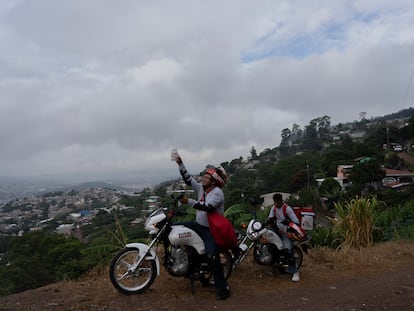‘The tsetse fly is attracted to the color blue’: How Guinea has managed to eliminate sleeping sickness as a public health problem
A comprehensive strategy that combines pharmacological advances, vector control, public outreach to raise awareness and community work has managed to drastically reduce cases of the disease. However, there are still challenges to overcome
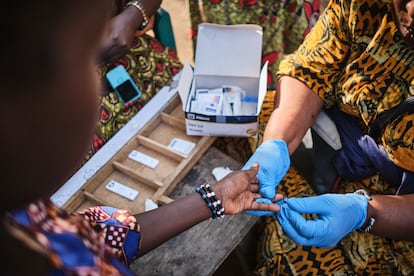
It’s 2012. While riding in a wooden motorboat, a team of scientists and researchers navigate the Fatala River, which passes through the small town of Boffa, in western Guinea. On both sides of the shore, thick roots are submerged in mud: these are mangroves, an ecosystem that’s difficult to access. The mangroves rely on the waters of the Atlantic Ocean.
They disembark and immediately sink their feet into grayish mud. And, although they don’t know it yet, what they’re about to do — placing a kind of blue target to lure and kill the tsetse fly — will greatly contribute to changing the course of sleeping sickness in Guinea.
Thirteen years later, these efforts have been rewarded with a historic victory: in January, the World Health Organization (WHO) declared that sleeping sickness had been eliminated as a public health problem in Guinea. After being the country with the most cases in West Africa in the early-2000s, by 2024, Guinea only registered 12 cases.
Human African Trypanosomiasis (HAT) — its scientific name — is also known as the “disease at the end of the road,” due to the challenges of reaching patients, who mostly live in rural areas. The most common symptoms are exhaustion, dermatitis, sleep disorders, aggression and psychosis. It can be fatal if left untreated. There are two variants: the Gambian variant — endemic in 24 countries in West and Central Africa, and responsible for more than 92% of cases — and the Rhodesian variant, present in 13 countries in East and Southern Africa, responsible for the remaining 8%. It mainly affects people who are employed by the agriculture and fishing sectors. It’s also one of the so-called “neglected tropical diseases” — that group of 21 ailments suffered by more than one billion people around the world, which are always accompanied by the same adjectives: poor, remote, neglected.
Sleeping sickness is caused by the Trypanosoma parasite and is transmitted by the tsetse fly. After biting a human who is infected with the parasite, the fly becomes infectious after three weeks. That fly will then bite another human, transmit the parasite and repeat the process until the end of its life cycle, which is about three months.
In Guinea, the tsetse fly has found its habitat in the density of the mangroves. “Between 2007 and 2012, we had a lot of difficulty controlling the disease. We were doing mass population screening, treating people, but we weren’t able to reduce the number of cases,” explains Bruno Bucheton, from the Research Institute for Development (IRD) in Conakry, the capital and the largest city of Guinea. Bucheton has been working to combat HAT since 2007. Following 2012, the researchers changed their strategy and focused on vector control: that is, reducing the number of flies.
A group of entomologists from the Liverpool School of Tropical Medicine and the IRD have succeeded in doing this by developing small blue fabric targets, which are coated with insecticide. These are called “tiny targets.”
“The tsetse fly is attracted to the color blue. It flies towards the fabric, touches it and, a few minutes later, it dies,” Bucheton explains. The devices don’t harm the ecosystem and only affect the tsetse fly, not other insects.
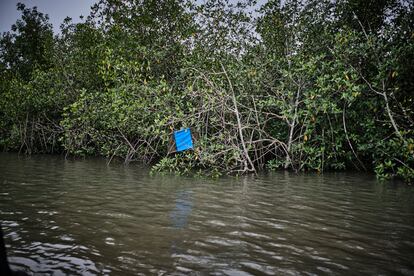
Upon arriving in Boffa, the team deployed the blue screens in the mangroves on the east bank of the river, to test their effectiveness. A year later, upon returning, they found that there were three times fewer cases in that area than on the west bank. “It was the first time we could demonstrate that they were effective and that they reduced prevalence,” Bucheton says. However, a few months later, in December 2013, something happened that paralyzed the country: the first case of Ebola was diagnosed in Guinea.
From one day to the next, Ebola became the priority. Confusion and paranoia took over the country and the social and health response was chaotic: no one was prepared for an emergency of such magnitude. Both the diagnosis and treatment of sleeping sickness stopped. However, one thing remained in place: the blue targets that had been given to the communities, which they themselves had continued to deploy. There are now more than 15,000 tiny targets spread across the mangroves in the three disease hotspots: Dubreka, Boffa and Forecariah.
It took two years before teams from IRD and the Guinea National Programme for the Control of Neglected Tropical Diseases (PNLMTN) — an organization created in 2002 by the Ministry of Health to control the disease — were able to return to the region. In 2016, they obtained their first results. “Without being able to diagnose or treat [HAT], we saw a huge increase in its prevalence. On the western side of the river, we found 69 cases. After Ebola, Guinea became the second country [the first being the Democratic Republic of Congo] with the most cases in all of Africa: 148. However, the eastern side of the river — where the blue cloths had been placed — was clean: zero cases,” Bucheton recalls.
The team shared the findings of their combined strategy of active detection, medical treatment and the fight against the proliferation of flies. The WHO — which, until then, had always advocated for case detection and treatment to be the first recommended method — had no choice but to include vector control in its guidelines as a key tool for controlling the disease. Today, walking through the mangroves of the Guinean coast means coming face to face with thousands upon thousands of these small blue cloth screens.
A history marked by neglect
The history of HAT in Africa is one of neglect. Although the disease was brought under control in the mid-1960s and the number of cases was reduced to less than 5,000 thanks to mass screening, it re-emerged in the 1970s when vigilance was relaxed. According to the WHO, “it reached epidemic proportions and, in 1998, nearly 40,000 cases were reported, in a context in which the number of undetected and untreated cases was estimated at around 300,000.”
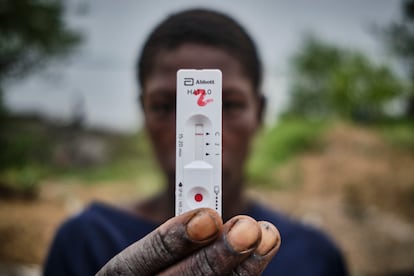
Medical advances and vector control have led to a dramatic drop in the number of reported cases of sleeping sickness in Africa over the past 20 years. According to the latest data from the WHO, between 1999 and 2023, the number of new cases fell by 98%, from 27,862 to 675 for the Gambian variant, while those of the Rhodesian variant fell from 619 to 24 in the same period. In Guinea, 24 new cases were recorded in 2023, while in 2024, there were only 12. “It wasn’t because we were lax. In fact, last year, we made 50% more diagnoses than in 2023. And we had half as many cases,” affirms Jean Mathieu Bart, a researcher at the IRD in Guinea.
Improving diagnosis and treatment
Oumou Camara has been working in the field since 2007. She’s Guinean, but was trained in Burkina Faso, where she was one of Dr. Bucheton’s students. Now that she’s responsible for diagnosis and screening in the national programme, she says that rapid tests “have changed the game.”
“In the past,” she notes, “you needed machinery, a means of transportation, electricity and a cold chain (a supply chain that uses refrigeration). Now, you can diagnose [a person] anywhere, in a matter of minutes,” she explains.
Until 2009, patients described the treatment for sleeping sickness as “fire in the veins.” Melarsoprol — a derivative of arsenic — was so toxic that it killed one in 20 patients and had to be administered intravenously with glass syringes, as it melted the plastic ones. Three years later, a clinical trial by the Drugs for Neglected Diseases Initiative (DNDi) and Médecins Sans Frontières (MSF, Doctors Without Borders) confirmed that NECT — a combination of two drugs — was safe and effective. “But it still poses a challenge for rural populations, as many people cannot afford to leave their jobs to accompany a patient during the 14 days of hospitalization,” Bart explains.
The revolution came at the end of 2018 in tablet form, when the European Medicines Agency (EMA) approved fexinidazole, a pill that allowed a 10-day treatment to be implemented from home. However, “it’s not as effective in the later stages of the disease as it is in the early stages. It can also cause nausea and discomfort,” Bart cautions. Despite this, it’s been available and used in Guinea since 2020 to treat patients in phase I and early phase II.
However, the research didn’t stop there. The DNDi continued working until it found a promising drug: acoziborole, a single oral dose of three tablets that has offered hope for ending HAT. “The efficacy is tremendous at all stages and we hope it will be approved in the second quarter of 2026. It’s a paradigm shift,” explains Olaf Valverde, leader of the DNDi clinical project on sleeping sickness. The pediatric version for children between the ages of zero and 14 — ACOZI-KIDS — is in phase II-III of the clinical trial.
A radio station to combat hoaxes
The telephone at Radio Communautaire Forecariah — a rural radio station — doesn’t stop ringing. The operator, Mamaisata Suma, controls the rhythms and gives the listeners the floor. This way, Mamadou Cissé — the journalist who hosts the program — can welcome them. The radio station was created in 2015 during the Ebola outbreak to raise awareness about the disease. The broadcast now provides educational information about sleeping sickness. “If people have information about the pathology, the cause and the symptoms, it’s much easier for medical teams to reach the communities and treat people,” Cissé explains to EL PAÍS, five minutes before going live.
The guests of this broadcast are Oumou Camara and Blo Mamadou Leno, members of the PNLMTN. Mamado Leno is a nurse with 40 years of experience. “People listen and then call to ask their questions, live,” Cissé says. “Fighting the disease isn’t just based on the medical part. Communication is a key element,” Bart emphasizes.
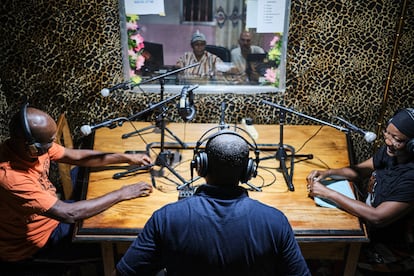
Eradication isn’t the end of the road. “Eliminating sleeping sickness as a public health problem means that, over the past five years, there have been fewer than one case per 10,000 inhabitants in Guinea. The next challenge, that of zero transmission — with the WHO having set the goal for 2030 — means that there will be no new cases over the same period,” Bart explains.
In January of this year alone, two new cases of the disease were confirmed in Dubreka. One of the afflicted individuals is Suma Abdulai, a 24-year-old young man. Suma is dazed, confused. His gaze is lost in space. Since he has no strength to speak, it’s his mother who does it for him. “One day, he started to feel tired; he had no energy. Soon after, he developed fevers, spots on his skin and weight loss. In the end, all he wanted to do was sleep,” she explains, sitting next to him in a room at the HAT Diagnostic and Treatment Center, in Dubreka. Suma is the first patient in Guinea to be diagnosed in 2025.
Translated by Avik Jain Chatlani
Sign up for our weekly newsletter to get more English-language news coverage from EL PAÍS USA Edition
Tu suscripción se está usando en otro dispositivo
¿Quieres añadir otro usuario a tu suscripción?
Si continúas leyendo en este dispositivo, no se podrá leer en el otro.
FlechaTu suscripción se está usando en otro dispositivo y solo puedes acceder a EL PAÍS desde un dispositivo a la vez.
Si quieres compartir tu cuenta, cambia tu suscripción a la modalidad Premium, así podrás añadir otro usuario. Cada uno accederá con su propia cuenta de email, lo que os permitirá personalizar vuestra experiencia en EL PAÍS.
¿Tienes una suscripción de empresa? Accede aquí para contratar más cuentas.
En el caso de no saber quién está usando tu cuenta, te recomendamos cambiar tu contraseña aquí.
Si decides continuar compartiendo tu cuenta, este mensaje se mostrará en tu dispositivo y en el de la otra persona que está usando tu cuenta de forma indefinida, afectando a tu experiencia de lectura. Puedes consultar aquí los términos y condiciones de la suscripción digital.
More information
Archived In
Últimas noticias
ICE raids trigger school absenteeism and traumatize children: ‘They have been forced to leave their childhood behind’
Mexico’s missing people crisis casts a shadow over World Cup venue
Can cheese protect brain health? This is what the science says
Maude Apatow, from acting in ‘Euphoria’ to directing: ‘There are many films that you can tell weren’t written by someone young’
Most viewed
- Christian Louboutin: ‘Young people don’t want to be like their parents. And if their parents wear sneakers, they’re going to look for something else’
- US sanctions against jailed cartel leader ‘El Marro’ highlight Mexico’s lack of control over its prisons
- Cartels in Mexico take a leap forward with narco-drones: ‘It is criminal groups that are leading the innovation race’
- Liset Menéndez de la Prida, neuroscientist: ‘It’s not normal to constantly seek pleasure; it’s important to be bored, to be calm’
- ‘El Limones’ and the growing union disguise of Mexican organized crime
